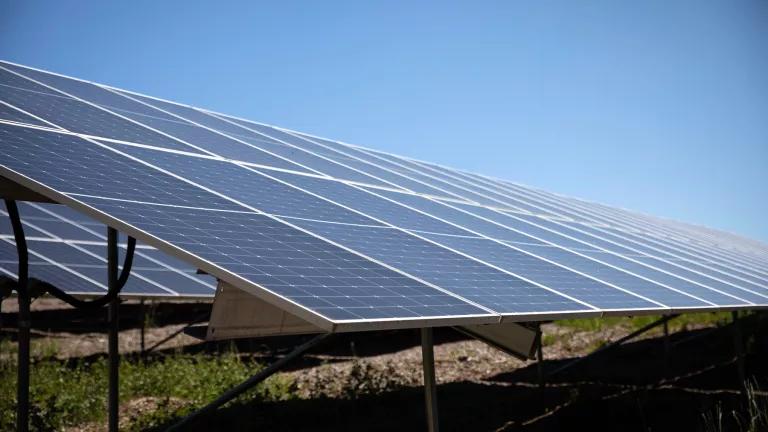As Heat Dome Approaches, PJM Continues Fighting New Energy
To face extreme weather, PJM needs to fix interconnection and allow new, clean resources to come online.

A heat dome creeps across the Northeastern United States.
NOAA
This week, a heat dome is bearing down on the East Coast. According to the National Weather Service, this will bring a “prolonged period of dangerously hot conditions” with “intense heat and high humidity.” As air conditioners ramp up, the grid will be tested. But the East Coast’s largest grid operator, PJM, is not doing everything in its power to boost its preparedness.
When it comes to adding new electricity sources, the nation’s largest grid operator, which serves 13 states from Illinois to Virginia, is stuck in the mud. Solar, wind and battery projects can’t get connected to the grid, and that poses are severe threat to reliability when extreme heat (or cold) hits.
This issue has long been the subject of scrutiny. In 2023 the New York Times ran a feature story on the barriers to entry for new energy, focusing largely on PJM, “The U.S. Has Billions for Wind and Solar Projects. Good Luck Plugging Them In.” And in 2023, NRDC released a report on the impact of interconnection delays in PJM, “Waiting Game: How the Interconnection Queue Threatens Renewable Development in PJM.”
As of September 2022, there were over 202 gigawatts (GW) of renewable energy resources waiting in the PJM queue, more than 95% of the total queue. For context, there were 200 GW of clean energy resources operating in the entire U.S. in 2021.
PJM's Interconnection Inaction
FERC issued Order 2023, which directed PJM and other regions to fix the interconnection problem, but PJM is refusing to act. This week, alongside a group of environmental organizations, we filed a protest to challenge PJM’s refusal to comply with Order 2023. Beyond interconnection, PJM also challenged and requested rehearing on FERC’s landmark Order 1920 – a landmark rule that would catalyze the buildout of regional transmission across the country.
PJM’s inaction is more than an obstacle to bringing cleaner and more affordable energy online. It’s an obstacle to building a reliable grid that can withstand extreme weather events that are becoming increasingly common under climate change. PJM themselves are raising alarms that they aren’t getting new resources plugged in fast enough to keep pace with needs, making it doubly puzzling why they are dragging their feet on solutions.
This isn’t just some regulatory squabble. The stakes are very real for the millions who live in PJM territory.
Take Winter Storm Elliott as an example. In December 2022, as temperatures plummeted, fossil power generation sources like gas and coal dropped offline en masse and without warning due to mechanical failures.
PJM narrowly avoided disaster and rolling blackouts across multiple states, but this near miss made it clear: we have a grid in PJM that will need more resources, and more diverse resources. While gas failed during Elliott, renewables pulled their weight and overperformed expectations.
PJM should look to the Lone Star state for inspiration. A similar phenomenon took place during the Texas heat dome last summer. For weeks, as a wave of extreme heat blanketed Texas and other parts of the South with temperatures as high as 118 degrees, renewable energy and storage helped Texans weather the storm.
During the heat dome, wind, solar, and storage contributed an extraordinary share of the state’s energy supply—at one point, renewables met almost 80% of Texas’s load. As daily electricity demand climbed up to very high levels during the prolonged heat wave, renewables kept pace, consistently meeting or exceeding the ERCOT forecast.
This readiness and resilience didn’t happen by accident. Texas steadily grew its base of new resources year-by-year, taking advantage of cheap, available, reliable energy. Texas has doubled its solar generation in 2023 and stands poised to do so again by the end of 2024, according to ERCOT. Storage is booming too. According to S&P Global Commodity Insights, Texas has nearly a third of the nation’s storage capacity. It also plans to double its battery storage within the next year.
It’s hardly credible for PJM to claim they can’t fix this problem when other parts of the country have efficient and responsive interconnection up and running.
With over 200GW in its queue, PJM could be years ahead in the same kind of growth and reliability increases that Texas has seen. PJM took a step in the right direction in May by approving more than 300 interconnection projects. But that approval still leaves it four to six years behind where they could and should be.

PJM’s current generation mix.
PJM Interconnection, 2023 Regional Transmission Expansion Plan.

The resource types currently waiting in the interconnection queue, which are overwhelmingly clean resources.
PJM Interconnection, 2023 Regional Transmission Expansion Plan.
We don’t have time to lose. Yet PJM continues to fight against additions to their grid and improvements to their process.
PJM’s current process is not enough to get these new clean energy projects connected to the grid as quickly as they’re needed. The grid operator has not even begun work on a single project proposed since the passage of the Inflation Reduction Act, the Illinois Climate and Equitable Jobs Act, the Virginia Clean Economy Act, or Maryland’s Climate Solutions Act.
Across both Order 1920 and Order 2023, PJM should leverage the work it’s already done to immediately and unilaterally begin planning that will meet FERC’s new standards. PJM doesn’t need to reinvent the wheel. It simply needs to comply with FERC’s interconnection and transmission planning rules.
If PJM wants to get serious about reliability and protecting its customers during extreme weather, it’s time to stop arguing about interconnection and transmission planning and get to work.



